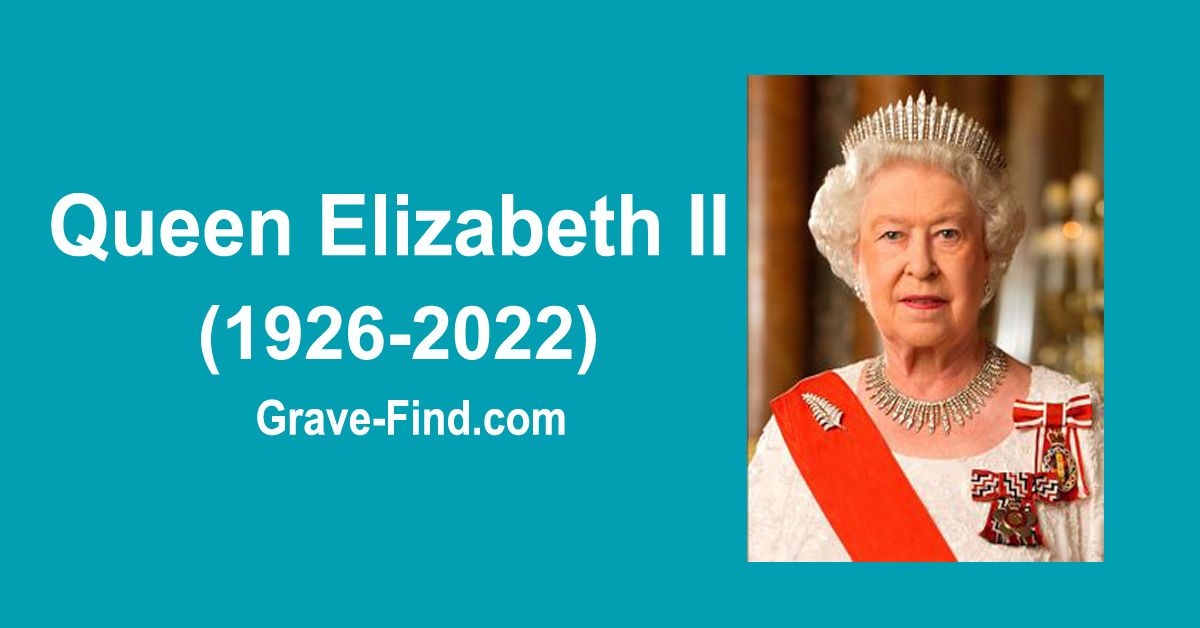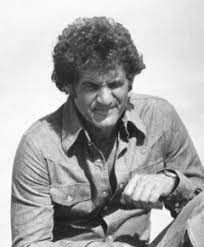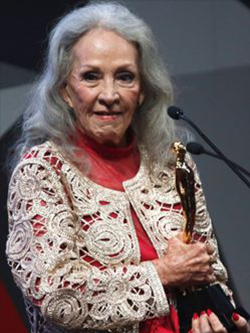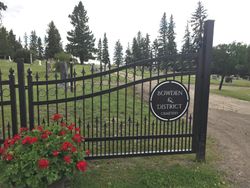Queen Elizabeth II (1926-2022) Find a Grave Memorial
Queen Elizabeth II (1926-2022) Find a Grave Memorial, queen Elizabeth II find a grave, Queen Elizabeth II Memorial
Elizabeth II was Queen of the United Kingdom and other Commonwealth realms from 6 February 1952 until her death in 2022. She was queen regnant of 32 sovereign states during her lifetime and 15 at the time of her death.
| Full Name | Elizabeth Alexandra Mary Windsor |
|---|---|
| BIRTH |
|
| DEATH | 8 September 2022 (aged 96)
Balmoral Castle, United Kingdom
|
| BURIAL |
Windsor, Windsor and Maidenhead Royal Borough, Berkshire, England
|
| PLOT | Royal Vault |
| SPOUSE | Prince Philip, Duke of Edinburgh (Married 1947–2021) |
| NATIONALITY | British |
Her reign of 70 years and 214 days is the longest of any British monarch, the longest recorded of any female head of state in history, and the second-longest verified reign of any sovereign in history.
Queen Elizabeth II Gravesite Details
To be interred in Royal Vault with HRH Phillip, which is in the George VI Memorial Chapel at Windsor Castle.
Queen Elizabeth II Bio
Born as the eldest grandchild of King George V, founder of the House of Windsor, her father was Prince Albert, the second eldest son of the monarch. As such, she was never expected to accede to the throne and subsequently enjoyed a relatively quiet childhood during the reign of her grandfather.
Upon the death of George V in the Winter of 1936, his eldest son, Prince Edward succeeded him as the King of the United Kingdom and Emperor of India. Edward’s reign proved to be the briefest in the history of the United Kingdom.
Due to his desire to marry American socialite and divorcee, Wallis Warfield Simpson, Edward was forced to abdicate the throne to pursue his romantic interest, thrusting both Prince Albert and his daughter into the forefront of the monarchy.
With her father assuming the regnal name of King George VI, the young Princess became the heir apparent to the crown. Her royal education quickly commenced, with private tutors instructing her on Constitution Monarch, law, and other pertinent courses. At the onset of the Second World War, the royal family cycled throughout the realm before settling down in Windsor Castle. While there the young Princess conducted her first radio address and solo public appearance.
To rally Londoners suffering during the German Blitzkrieg, she helped tend a victory garden at the royal palace. Shortly before the end of the war, Elizabeth enrolled in the Auxiliary Territorial Service, the female branch of the British Armed Forces.
Attaining a rank of Junior Commander, she qualified in a number of courses including mechanics, driving, and vehicular maintenance.
On May 8, 1945, now known as Victory in Europe Day, she appeared alongside her parents, younger sister, and Prime Minister Churchill on the balcony of Buckingham Palace. Two years after the conclusion of the war, Elizabeth became officially engaged to Prince Philip of Greece and Denmark, a minor grandchild of King George I of Greece.
After a four month engagement and Philip’s renunciation of his foreign royal titles, the two were married by the Archbishop of Canterbury in London’s famed Westminster Abbey. The wedding was televised and broadcast to over two-hundred million people across the globe.
Nearly one year later, their eldest child, Charles, Prince of Wales was born. Two years later came their only daughter, Princess Anne. It was during this time that King George VI’s health began a precipitous decline. As a lifelong smoker, he had undergone removal of a cancerous lung and suffered from impair breathing and heart function.
In February of 1952, Elizabeth and Philip departed England for a royal tour of the British Commonwealth. While in Kenya, Philip was forced to deliver the somber news that the King had passed in his sleep, and as such Elizabeth was now Queen of the seven independent states of the Commonwealth.
Returning to England, the couple moved into the royal residence at Buckingham Palace. On June 2, 1953 she was officially coronated at Westminster Abbey. The momentous occasion was the first coronation of a British monarch to be televised. The first years of her reign proved pivotal. A number of crises arose across the world stage.
The post-war British economy was slow to recover and several former British possessions began to seek independence from their longtime holder. The Queen and her consort embarked upon numerous global tours of the members nations and their allies. She became the first British monarch to visit Australia and New Zealand, in addition to becoming the first to open the Royal Canadian Parliament in person.
In 1957 she became only the second monarch to visit the United States while conducting her North American Tour. At this time she became the first British Queen to address the United Nations General Assembly. Over the next decade the Commonwealth over which she had presided since the age of 27 began a dramatic transformation. Numerous British holdings in the Caribbean, Africa, and the Far East transitioned to self rule.
Other counties declared independence, breaking away from British governance all together. The Queen and her consort had two more sons during this time, Prince Andrew who was born in 1960 and Prince Edward in 1964. Five years later she presided over the investiture of Prince Charles as the Prince of Wales, officially installing him as the heir apparent.
In 1977 the Queen celebrated her Silver Jubilee marking twenty-five years on the throne. The subsequent decade proved to be an eventful one for the Queen. In 1982 she was forced to deploy her armed forces to the South Atlantic to push back Argentinian troops which had occupied the British Oversea Territories of the Falkland Islands.
Unpopular policies under the Thatcher administration also put her majesty’s public popularity at risk. By time of her Ruby Jubilee in 1992, the Queen was undergoing her self labeled, “Annus Horribilis” or horrible year. A catastrophic fire destroyed a large section of Windsor Castle, three of her children’s marriages came to an end, and public sentiment against her rule hit an all time low.
In 1997 following the death of her former daughter-in-law Diana, Princess of Wales, the Queen was pressured to make a special address to the nation in order to alleviate the public’s sense of a remorseless monarchy. The televised speech soothe the agitated nerves of the masses and helped to begin the restoration of her high public esteem. In 2002, she became only the sixth English monarch to have reigned fifty years on the throne.
The joyous occasion was punctuated with twin losses for the Queen, as her mother, Queen Elizabeth, the Queen Mother and her only sibling, Princess Margaret passed away within a month of each other. In 2007 she and Prince Philip became the first British monarch and consort to celebrate a diamond wedding anniversary.
She also surpassed her ancestor Queen Victoria as the longest lived British monarch. At the outset of the new decade, the Queen continued to break records with her reign’s longevity. 2012 saw the nationwide celebration of her Diamond Jubilee marking sixty years on the throne. Only Queen Victoria had previously served as long on the throne. That same year she opened her second Olympic Games.
Three years later she officially became the longest reigning British monarch when she again surpassed the longstanding record set by Queen Victoria in 1897. In February of 2017 she became the first British monarch to celebrate a Sapphire Jubilee and later that year became the only to commemorate a platinum wedding anniversary.
Queen Elizabeth II (1926-2022) Find a Grave Memorial
With the outbreak of Covid-19 and the subsequent global pandemic came special challenges to overcome. With the country locked down in quarantine, the Queen quarantined within the walls of Windsor. Realizing the power of her words, and the necessity of hope, she released only the fifth special address in her exceptionally long reign.
Her broadcasts sought to strengthen the spirits of the British people, echoing the words of her father’s wartime speeches seventy-five years before. On April 9, 2021 the Queen suffered another tremendous loss with the passing of her husband, Prince Philip. The following February she was honored with her Platinum Jubilee, marking seventy years of service on the throne.
Due to a number of health issues stemming from her age, she decided to forgo the May opening of Parliament, marking only the third time in her reign that she had not been present to convene the British legislature.
A number of her royal duties were delegated to Prince Charles and his eldest son, Prince William who were designated as Counsellors of State. The Queen continued to enjoy an extraordinarily high public approval not only by the British citizens, but the globally community. Her public image has been replicated throughout a wide assortment of media ranging from music, books, television, and film.
Queen Elizabeth II (1926-2022) Find a Grave Memorial






